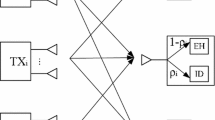Abstract
Simultaneous wireless information and power transfer (SWIPT) is a promising solution to carry energy as well as information at the same time for wireless networks. In this paper, we consider a precoding matrix design for multiple-input multiple-output (MIMO) SWIPT systems with finite-alphabet inputs. The problem can be formulated as maximizing the mutual information given the energy level and the power constraint for achieving a so-called rate-energy region. The formulated problem is non-concave, which can be reduced to a convex power allocation problem by the proposed gradient-descend design of the precoding matrix. Several rate-energy regions can be achieved by trading off between the information rate and the harvested energy with different schemes. Simulation results indicate that the proposed scheme with finite-alphabet inputs provides significant performance gain over existing schemes with Gaussian inputs.







Similar content being viewed by others
References
Krikidis, I., Timotheou, S., Nikolaou, S., Zheng, G., Ng, D. W. K., & Schober, R. (2014). Simultaneous wireless information and power transfer in modern communication systems. IEEE Communications Magazine, 52(11), 104–110.
Liu, Y., & Wang, X. (2016). Information and energy cooperation in OFDM relaying: Protocols and optimization. IEEE Transactions on Vehicular Technology, 65(7), 5088–5098.
Zhang, M., Liu, Y., & Zhang, R. (2016). Artificial noise aided secrecy information and power transfer in OFDMA systems. IEEE Transactions on Wireless Communications, 15(4), 3085–3096.
Zhang, M., & Liu, Y. (2016). Energy harvesting for physical-layer security in OFDMA networks. IEEE Transactions on Information Forensics and Security, 11(1), 154–162.
Liu, Y. (2016). Wireless information and power transfer for multirelay-assisted cooperative communication. IEEE Communications Letters, 20(4), 784–787.
Lu, X., Wang, P., Niyato, D., Kim, D. I., & Han, H. (2015). Wireless networks with RF energy harvesting: A contemporary survey. IEEE Communications Surveys & Tutorials, 17(2), 757–789.
Bi, S., Zeng, Y., & Zhang, R. (2016). Wireless powered communication networks: An overview. IEEE Wireless Communications, 23(2), 10–18.
Bi, S., Ho, C. K., & Zhang, R. (2015). Wireless powered communication: Opportunities and challenges. IEEE Communications Magazine, 53(4), 117–125.
Zhang, R., & Ho, C. K. (2013). MIMO broadcasting for simultaneous wireless information and power transfer. IEEE Transactions on Wireless Communications, 12(5), 1989–2001.
Khandaker, M. R. A., & Wong, K. (2014). SWIPT in MISO multicasting systems. IEEE Wireless Communications Letters, 3(3), 277–280.
Ulukus, S., Yener, A., Erkip, E., Simeone, O., Zorzi, M., Grover, P., & Huang, K. (2015). Energy harvesting wireless communications: A review of recent advances. IEEE Journal on Selected Areas in Communications, 33(3), 360–381.
Ju, H., & Zhang, R. (2014). Throughput maximization in wireless powered communication networks. IEEE Transactions on Wireless Communications, 13(1), 418–428.
Sun, Q., Zhu, G., Shen, C., Li, X., & Zhong, Z. (2014). Joint beamforming design and time allocation for wireless powered communication networks. IEEE Communications Letters, 18(10), 1783–1786.
Lee, H., Lee, K. J., Kong, H. B., & Lee, I. (2016). Sum-rate maximization for multiuser MIMO wireless powered communication networks. IEEE Transactions on Vehicular Technology, 65(11), 9420–9424.
Lozano, A., Tulino, A., & Verd, S. (2006). Optimum power allocation for parallel Gaussian channels with arbitrary input distributions. IEEE Transactions on Information Theory, 52(7), 3033–3051.
Xiao, C., & Zheng, Y. R. (2008). On the mutual information and power allocation for vector Gaussian channels with finite discrete inputs. In Proceeding of the GLOBECOM, 2008 (pp. 1–5), Nov 2008.
Xiao, C., Zheng, Y. R., & Ding, Z. (2011). Globally optimal linear precoders for finite alphabet signals over complex vector Gaussian channels. IEEE Transactions on Signal Processing, 59(7), 3301–3314.
Zeng, W., Xiao, C., & Lu, J. (2012). A low-complexity design of linear precoding for MIMO channels with finite-alphabet inputs. IEEE Wireless Communications Letters, 1(1), 38–41.
Zeng, W., Zheng, Y. R., & Schober, R. (2015). Online resource allocation for energy harvesting downlink multiuser systems: Precoding with modulation, coding rate, and subchannel selection. IEEE Transactions on Wireless Communications, 14(10), 5780–5794.
Zeng, W., Xiao, C., Wang, M., & Lu, J. (2012). Linear precoding for finite-alphabet inputs over MIMO fading channels with statistical CSI. IEEE Transactions on Signal Processing, 60(6), 3134–3148.
Wu, Y., Wen, C. K., Xiao, C., Gao, X., & Schober, R. (2015). Linear precoding for the MIMO multiple access channel with finite alphabet inputs and statistical CSI. IEEE Transactions on Wireless Communications, 14(2), 983–997.
Boyd, S., & Vandenberghe, L. (2004). Convex optimization. Cambridge: Cambridge University Press.
Zeng, W., Zheng, Y. R., & Xiao, C. (2016). Online precoding for energy harvesting transmitter with finite-alphabet inputs and statistical CSI. IEEE Transactions on Vehicular Technology, 65(7), 5287–5302.
Zheng, Y. R., Wang, M., Zeng, W., & Xiao, C. (2013). Practical linear precoder design for finite alphabet multiple-input multiple-output orthogonal frequency division multiplexing with experiment validation. IET Communications, 7(9), 836–847.
Magnus, J., & Neudecker, H. (2007). Matrix differential calculus with applications in statistics and econometrics (3rd ed.). New York: Wiley.
Cover, T. M., & Thomas, J. A. (1990). Elements of information theory. New York: Wiley.
Xin, Y., Wang, Z., & Giannakis, G. B. (2003). Space-time diversity systems based on linear constellation precoding. IEEE Transactions on Wireless Communicaitons, 2(2), 294–309.
Author information
Authors and Affiliations
Corresponding author
Rights and permissions
About this article
Cite this article
Ke, F., Huang, X., Liu, Y. et al. Simultaneous Wireless Information and Power Transfer with Finite-Alphabet Inputs. Wireless Pers Commun 96, 655–668 (2017). https://doi.org/10.1007/s11277-017-4194-3
Published:
Issue Date:
DOI: https://doi.org/10.1007/s11277-017-4194-3




